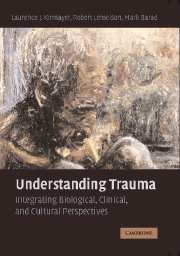Book contents
- Frontmatter
- Contents
- List of Figures
- List of Tables
- List of Contributors
- Foreword by Robert Jay Lifton
- Preface
- List of Abbreviations
- Introduction: Inscribing Trauma in Culture, Brain, and Body
- SECTION I NEUROBIOLOGICAL PERSPECTIVES ON TRAUMA
- SECTION II CLINICAL PERSPECTIVES ON TRAUMA
- SECTION III CULTURAL PERSPECTIVES ON TRAUMA
- 15 Trauma, Adaptation, and Resilience: A Cross-Cultural and Evolutionary Perspective
- 16 Bruno and the Holy Fool: Myth, Mimesis, and the Transmission of Traumatic Memories
- 17 Failures of Imagination: The Refugee's Predicament
- 18 Trauma, Culture, and Myth: Narratives of the Ethiopian Jewish Exodus
- 19 Posttraumatic Politics: Violence, Memory, and Biomedical Discourse in Bali
- 20 Terror and Trauma in the Cambodian Genocide
- 21 Trauma in Context: Integrating Biological, Clinical, and Cultural Perspectives
- Epilogue: Trauma and the Vicissitudes of Interdisciplinary Integration
- Glossary
- Index
- References
16 - Bruno and the Holy Fool: Myth, Mimesis, and the Transmission of Traumatic Memories
Published online by Cambridge University Press: 27 July 2009
- Frontmatter
- Contents
- List of Figures
- List of Tables
- List of Contributors
- Foreword by Robert Jay Lifton
- Preface
- List of Abbreviations
- Introduction: Inscribing Trauma in Culture, Brain, and Body
- SECTION I NEUROBIOLOGICAL PERSPECTIVES ON TRAUMA
- SECTION II CLINICAL PERSPECTIVES ON TRAUMA
- SECTION III CULTURAL PERSPECTIVES ON TRAUMA
- 15 Trauma, Adaptation, and Resilience: A Cross-Cultural and Evolutionary Perspective
- 16 Bruno and the Holy Fool: Myth, Mimesis, and the Transmission of Traumatic Memories
- 17 Failures of Imagination: The Refugee's Predicament
- 18 Trauma, Culture, and Myth: Narratives of the Ethiopian Jewish Exodus
- 19 Posttraumatic Politics: Violence, Memory, and Biomedical Discourse in Bali
- 20 Terror and Trauma in the Cambodian Genocide
- 21 Trauma in Context: Integrating Biological, Clinical, and Cultural Perspectives
- Epilogue: Trauma and the Vicissitudes of Interdisciplinary Integration
- Glossary
- Index
- References
Summary
One of the ways in which people make collective sense of the world is by connecting the present time to past time through participation in myth and ritual. In some rituals, people make the connection through conventional symbols and perfunctory displays of emotion. The annual Remembrance Day ceremony in Britain and Canada, commemorating the war dead, is an example. In another class of rituals, people engage the past through myth and mimesis. By myth I mean a narrative that is historically problematic and is shared by a group of people who believe that it is credible, explains their collective identity, and illuminates their present condition. The “truth” of these narratives and collective memories resides less in their “factuality” than their “actuality” (Assmann, 1997, p. 9). Mimesis refers to efforts, often in the context of ritual, aimed at imitating or identifying with people and tropes (figurative descriptions of people) from the past.
This chapter explores how myth and mimesis are linked to trauma and its signature condition, posttraumatic stress disorder (PTSD). For reasons that will become obvious, I begin with an old ritual, the Passover seder, and an even older myth, the Exodus narrative. The seder comprises a ritual meal and a collection of recitations, prayers, and songs, set down in a text called a haggadah. In the course of the seder, participants are admonished to identify themselves with their ancestors' experiences during their bondage in Egypt and the journey through the Sinai.
- Type
- Chapter
- Information
- Understanding TraumaIntegrating Biological, Clinical, and Cultural Perspectives, pp. 339 - 362Publisher: Cambridge University PressPrint publication year: 2007
References
- 16
- Cited by

